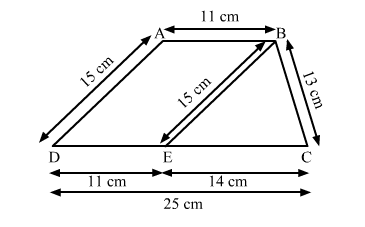Find the area of a trapezium whose parallel sides are 11 m and 25 m long, and the nonparallel sides are 15 m and 13 m long.
In the given figure, ABCD is the trapezium.

Draw a line BE parallel to AD.
In ∆BCE,
The sides of the triangle are of length 15 m, 13 m and 14 m.
∴ Semi-perimeter of the triangle is
$s=\frac{15+13+14}{2}=\frac{42}{2}=21 \mathrm{~m}$
∴ By Heron's formula,
Area of $\Delta B C E=\sqrt{s(s-a)(s-b)(s-c)}$
$=\sqrt{21(21-15)(21-13)(21-14)}$
$=\sqrt{21(6)(8)(7)}$
$=84 \mathrm{~m}^{2} \quad \ldots(1)$
Also,
Area of $\Delta B C E=\frac{1}{2} \times$ Base $\times$ Height
$\Rightarrow 84=\frac{1}{2} \times 14 \times$ Height
$\Rightarrow 84=7 \times$ Height
$\Rightarrow$ Height $=\frac{84}{7}$
$\Rightarrow$ Height $=12 \mathrm{~m}$
∴ Height of ∆BCE = Height of the parallelogram ABED = 12 m
Now,
Area of the parallelogram ABED = Base × Height
= 11 × 12
= 132 m2 ...(2)
∴ Area of the trapezium = Area of the parallelogram ABED + Area of the triangle BCE
= 132 + 84
= 216 m2
Hence, the area of a trapezium is 216 m2.
